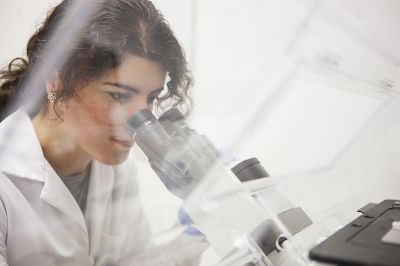
For Breast Cancer Awareness Month Dr Anabel Sorolla wrote about her work developing specialised nanoparticles to treat aggressive breast cancer.
At the Harry Perkins Institute of Medical Research, a Cancer Epigenetics team is investigating ways to leverage the great opportunities that nanotechnology offers in the treatment of one of the most challenging cancers, triple negative breast cancer.
With Associate Professor Pilar Blancafort and the Cancer Epigenetics team, I am designing modern medicines and developing new treatments for triple negative breast cancers using polymeric nanoparticles.
Triple negative breast cancers comprise ~20 per cent of all breast cancers and they still lack a targeted therapy, in part because they do not express oestrogen and progesterone receptors and HER2 (human epidermal growth factor receptor 2) – the three most common “druggable” targets in breast cancer.
Currently there are a few nanoparticles approved for breast cancer treatment. One of them is known as Abraxane® (paclitaxel nanoparticles) which was approved in 2005 by the Food and Drug Administration for the treatment of metastatic breast cancer.
These paclitaxel nanoparticles can be transported better in the bloodstream, absorbed easier by the tumour cells and are less toxic than free paclitaxel.
Despite all these advantages, Abraxane and current nanoformulations for anti-cancer treatment are still untargeted. So, they are not selective for tumour cells and they preferentially accumulate in the spleen, liver and kidneys for their clearance.
In our laboratory at Perkins, we are developing novel modalities to change this therapeutic scenario.
In particular, we are decorating nanoparticles with RGD peptides, which are peptides able to recognise and bind with high affinity to the integrin receptors present in high abundance in triple negative breast cancer, with the aim of concentrating the nanoparticles in the tumour.
In addition, the RGD peptides are linked to interference peptides. Interference peptides are short amino acid sequences able to bind and disrupt protein-protein interactions between transcription factors. It has been shown that triple negative breast cancer cells selectively overexpress a certain transcription factor that activates proliferation and drug resistance mechanisms in tumour cells.
By using interference peptides, we can block the action of the transcription factor thereby hampering drug resistance pathways arising in the tumours while sensitising cells to chemotherapeutic drugs de novo.
Importantly, inhibiting drug resistance mechanisms can prevent tumour relapse and metastasis.
The cutting-edge nanoparticles developed in our laboratory for triple negative breast cancer treatment can represent the first targeted therapy for these cancers, which are still considered incurable.
The value of nanoparticles is that they are very tiny carriers, approximately one thousandth of a millimeter. They can have different shapes and compositions although the most common ones are spherical micelles made of lipids.
They have been used in recent decades to transport hydrophobic substances such as ingredients used in cosmetics creams or detergents. In medicine, they have revolutionised the treatment landscape of many illnesses including cancer, iron deficiency, meningitis and macular degeneration.
Nanoparticles possess unique characteristics. They can encapsulate infinity of therapeutic agents such as DNA, RNA and chemotherapeutic drugs and at the same time protect their stability. The size and the shape of nanoparticles can be controlled so that they can achieve a greater accumulation in certain parts of the body such as a tumour or the brain.
Nanoparticles can be decorated with albumin or polyethylene glycol to avoid their recognition by the immune cells and subsequent destruction. They can also be coated with antibodies or peptides recognisable by the surface molecules of specific cells that facilitate the interaction and thus the entry of the nanoparticles into specific cells while not in others.
In summary, nanoparticles represent a powerful tool for the design of cutting-edge, effective and more selective future medicines, opening an important avenue for so-called personalised medicine.
